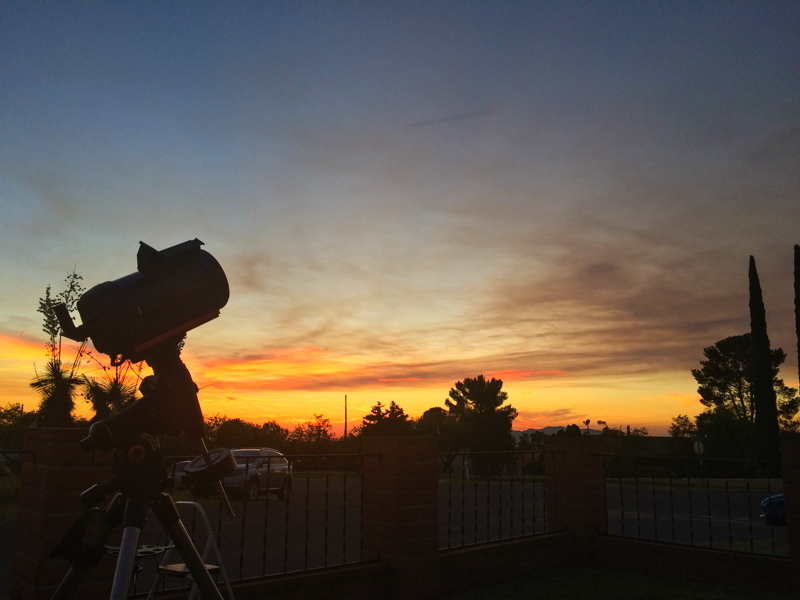Neighborhood Star Party, Smokey Sky, ISS
Posted: 18 June 2015
Tuesday, 16 June 2015, had unforecasted clouds, which continued into Wednesday morning, 17 June. That evening, under clear but smokey skies, I attended a neighborhood star party organized by a local family. There was smoke in the northern sky from a new wildfire just outside the town of Kearny, about 30 miles away, as seen in this iPhone panoramic photo from late in the afternoon just before I left home to go to the star party:

Click or tap on image for larger version
The smokey sky made for a pretty sunset:

The 8" Celestron telescope was provided by Starizona, with two people from the store, including the owner, at the star party.
A thin crescent Moon made a brief appearance, as seen in this iPhone 5s photo taken at 2010 MST:

Mouseover or tap on image to see a pointer to the Moon
By 2017 MST, Jupiter, Venus, and the crescent Moon were visible in the smokey sky:

Mouseover or tap on image too see labels
The star party was extremely well-attended by many Oracle families. It was exciting to see and hear the local interest in the night sky.
I left the star party early to open the observatory. Even though the sky was covered by smoke from the Kearny wildfire, I still wanted to attempt imaging of the night's pass of the International Space Station (ISS) through the Meade 8" LX200-ACF telescope.
|
Open: Wednesday, 17 June 2015, 2045 MST Temperature: 88°F |
Session: 837 Conditions: Clear but smokey sky |
The smoke from the Kearny wildfire continued to cover the entire sky. I decided to cancel all my planned Deep Sky Object (DSO) imaging but still wanted to try for the ISS. I'm still tweaking exposure settings on my new D7200 DSLR in my attempts to get the best image of the ISS through the 8" telescope.
2054 MST: viewed Venus, 83X, followed by Jupiter, 83X. The four Galilean moons were visible to the right of the planet: Ganymede, Io, Europa, and Callisto. Then viewed Saturn, 83X. Five moons were visible: Iapetus, Titan, Rhea, Tethys, and Dione.
Next, I updated the ISS TLE in the AutoStar. I mounted the D7200 DSLR at prime focus of the 8" and did a focus test image on the star Spica using a Bahtinov Mask.
I made a slight adjustment in the finderscope alignment and by 2112 MST I was ready for the ISS pass to start at 2128 MST. The pass would start low in the northwestern sky, behind some trees.
Once I picked up the ISS in the finderscope and centered it, automatic tracking was fairly good during the first half of the pass. But as usually happens, once the ISS approached the North Celestial Pole, the tracking went berserk and I was unable to manually keep the ISS centered in the finderscope. The low elevation pass meant that the ISS was not especially close to the observatory but I was able to capture some of the shape of the Space Station in this frame from the HD video, 1.3X crop factor, 60 fps, 1/1000sec, ISO 3200:

The gold solar panels are faintly visible to either side of the main station core. This is certainly not my best image of the ISS as you can tell from the other images on my Satellite photo album page. I still need to refine the exposure settings.
2139 MST: removed the camera from the 8" telescope and took a quick look at Saturn, 83X.
Then closed up for the night due to the smokey sky.
|
Close: Wednesday, 17 June 2015, 2149 MST Temperature: 81°F |
|
If you are still having a problem viewing the video of the night sky at Oracle State Park that was on my report from Saturday, 13 October, you may be able to view this much smaller (8.8 MB) version:

Click or tap on image to watch video
Comments are welcome using Email. If you are on Twitter you can use the button below to tweet this report to your followers. Thanks.
Cassiopeia Observatory Home Page
Copyright ©2015 Michael L. Weasner / mweasner@me.com
URL = http://www.weasner.com/co/Reports/2015/06/18/index.html
